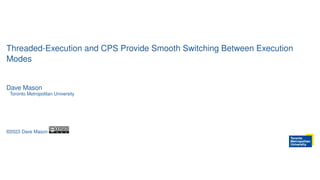
Threaded-Execution and CPS Provide Smooth Switching Between Execution Modes
- 1. Threaded-Execution and CPS Provide Smooth Switching Between Execution Modes Dave Mason Toronto Metropolitan University ©2023 Dave Mason
- 2. Execution Models Source Interpretation Bytecode Interpretation Threaded Execution Hardware Interpretation
- 3. Timing of Fibonacci Thread CPS Object NativePharo JIT 169 278 347 1,094 559 186 304 391 1,918 591 136 332 564 2,010 695 Apple M1 Apple M2 Pro Intel i7 2.8GHz Threaded is 2.3-4.7 times faster than bytecode.
- 4. Zag Smalltalk supports 2 models: threaded and native CPS seamless transition threaded is smaller and fully supports step-debugging native is 3-5 times faster and can fallback to full debugging after a send
- 5. Threaded Execution sequence of addresses of native code like an extensible bytecode each word passes control to the next associated with Forth, originally in PDP-11 FORTRAN compiler, was used in BrouHaHa
- 6. fibonacci 1 fibonacci 2 self <= 2 ifTrue: [ ↑ 1 ]. 3 ↑ (self - 1) fibonacci + (self - 2) fibonacci
- 7. Threaded fibonacci 1 verifySelector, 2 ":recurse", 3 dup, // self 4 pushLiteral, Object.from(2), 5 p5, // <= 6 ifFalse,"label3", 7 drop, // self 8 pushLiteral1, 9 returnNoContext, 10 ":label3", 11 pushContext,"^", 12 pushLocal0, // self 13 pushLiteral1, 14 p2, // - 15 callRecursive, "recurse", 16 pushLocal0, //self 17 pushLiteral2, 18 p2, // - 19 callRecursive, "recurse", 20 p1, // + 21 returnTop,
- 8. Some control words 1 pub fn drop(pc:PC, sp:Stack, process:*Process, context:ContextPtr, selector:Object) Stack { 2 tailcall pc[0].prim(pc+1, sp+1, process, context, selector, cache); 3 } 4 pub fn dup(pc:PC, sp:Stack, process:*Process, context:ContextPtr, selector:Object) Stack { 5 const newSp = sp-1; 6 newSp[0] = newSp[1]; 7 tailcall pc[0].prim(pc+1, newSp, process, context, selector, cache); 8 } 9 pub fn ifFalse(pc:PC, sp:Stack, process:*Process, context:ContextPtr, selector:Object) Stack { 10 const v = sp[0]; 11 if (False.equals(v)) tailcall branch(pc, sp+1, process, context, selector, cache ); 12 if (True.equals(v)) tailcall pc[1].prim(pc+2, sp+1, process, context, selector, cache ); 13 @panic("non boolean"); 14 } 15 pub fn p1(pc:PC, sp:Stack, process:*Process, context:ContextPtr, selector:Object) Stack { 16 if (!Sym.@"+".selectorEquals(selector)) tailcall dnu(pc, sp, process, context, selector); 17 sp[1] = inlines.p1(sp[1], sp[0]) 18 catch tailcall pc[0].prim(pc+1, sp, process, context, selector, cache); 19 tailcall context.npc(context.tpc, sp+1, process, context, selector, cache); 20 }
- 9. Continuation Passing Style continuation is the rest of the program comes from optimization of functional languages (continuation was a closure) no implicit stack frames - passed explicitly like the original Smalltalk passing Context (maybe not obvious that Context is a special kind of closure)
- 10. Normal Style 1 pub fn fibNative(self: i64) i64 { 2 if (self <= 2) return 1; 3 return fibNative(self - 1) + fibNative(self - 2); 4 } 5 const one = Object.from(1); 6 const two = Object.from(2); 7 pub fn fibObject(self: Object) Object { 8 if (i.p5N(self,two)) return one; 9 const m1 = i.p2L(self, 1) catch @panic("int subtract failed in fibObject"); 10 const fm1 = fibObject(m1); 11 const m2 = i.p2L(self, 2) catch @panic("int subtract failed in fibObject"); 12 const fm2 = fibObject(m2); 13 return i.p1(fm1, fm2) catch @panic("int add failed in fibObject"); 14 }
- 11. Continuation Passing Style 1 pub fn fibCPS(pc:PC, sp:Stack, process:*Process, context:ContextPtr, selector:Object) Stack { 2 if (!fibSym.equals(selector)) tailcall dnu(pc,sp,process,context,selector); 3 if (inlined.p5N(sp[0],Object.from(2))) { 4 sp[0] = Object.from(1); 5 tailcall context.npc(context.tpc,sp,process,context,selector); 6 } 7 const newContext = context.push(sp,process,fibThread.asCompiledMethodPtr(),0,2,0); 8 const newSp = newContext.sp(); 9 newSp[0]=inlined.p2L(sp[0],1) 10 catch tailcall pc[10].prim(pc+11,newSp+1,process,context,fibSym); 11 newContext.setReturnBoth(fibCPS1, pc+13); // after first callRecursive (line 15 above) 12 tailcall fibCPS(fibCPST+1,newSp,process,newContext,fibSym); 13 }
- 12. Continuation Passing Style 1 fn fibCPS1(pc:PC, sp:Stack, process:*Process, context:ContextPtr, _:Object) Stack { 2 const newSp = sp.push(); 3 newSp[0] = inlined.p2L(context.getTemp(0),2) 4 catch tailcall pc[0].prim(pc+1,newSp,process,context,fibSym)); 5 context.setReturnBoth(fibCPS2, pc+3); // after 2nd callRecursive (line 19 above) 6 tailcall fibCPS(fibCPST+1,newSp,process,context,fibSym); 7 }
- 13. Continuation Passing Style 1 fn fibCPS2(pc:PC, sp:Stack, process:*Process, context:ContextPtr, selector:Object) Stack { 2 const sum = inlined.p1(sp[1],sp[0]) 3 catch tailcall pc[0].prim(pc+1,sp,process,context,fibSym); 4 const result = context.pop(process); 5 const newSp = result.sp; 6 newSp.put0(sum); 7 const callerContext = result.ctxt; 8 tailcall callerContext.npc(callerContext.tpc,newSp,process,callerContext,selector); 9 }
- 14. Implementation Decisions Context must contain not only native return points, but also threaded return points; CompiledMethods must facilitate seamless switching between execution modes; the stack cannot reasonably be woven into the hardware stack with function calls, so no native stack; as well as parameters, locals, and working space, stack is used to allocate Context and BlockClosure as usually released in LIFO pattern
- 15. Conclusions with proper structures, can easily switch between threaded and native code threaded code is “good enough” for many purposes this is preliminary work, so some open questions many experiments to run to validate my intuitions many more details in the paper
- 17. Timing of Fibonacci Thread CPS P-JIT P-Stack Z-Byte 347 1,094 559 5,033 4,730 391 1,918 591 3,527 4,820 564 2,010 695 3,568 4,609 Apple M1 Apple M2 Pro Intel i7 2.8GHz M2 P-Stack is presumed to be mis-configured